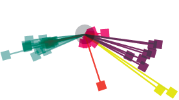Creation
When creating digital still images one is constrained by the limitations of the capture device. Digital cameras provide only a few formats namely RAW, TIFF and JPEG.
The RAW format is always the camera manufacturer's proprietary RAW format and is nearly always the default choice for capture as it provides the greatest latitudes in relation to exposure, colour and contrast control.
If the user is able to control these elements outside of the capture device with the use of lighting, and wishes to post process the images as little as possible, then the TIFF format is a possibility although, given the lack of compression, this can create issues around file storage. JPEG is normally considered as a delivery format only but is offered as a capture format in cameras when used in conjunction with RAW.
Cameras often provide the facility to capture RAW and JPEG simultaneously; the JPEG being used as a 'belt and braces' or reference image only. However, under certain conditions it is desirable to capture as many images as possible in very rapid bursts. This is often the case in press photography and high speed motion capture. In these instances the JPEG format is often chosen for its smaller file size and therefore speed of buffering and processing.
Scanners are the other main form of capture device and provide only the TIFF and JPEG formats for capture. Given that, when all auto settings are turned off, the resulting image is relatively flat in tone and contrast, this allows for extensive post production without discernible loss of image quality.

